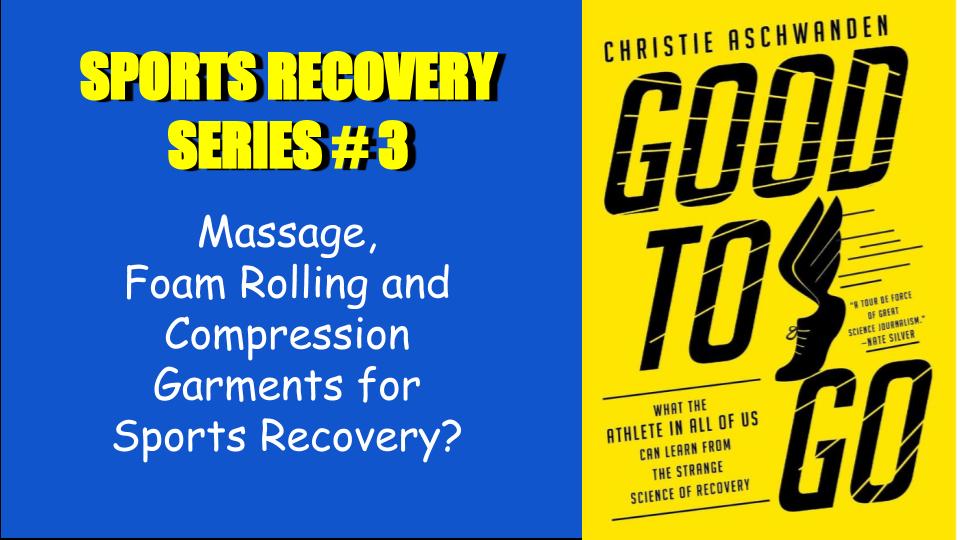Massage, Foam Rolling, and Compression Garment for Sports Recovery.
Does massage and foam rolling decrease muscle soreness?
Who doesn’t like a good massage, but does it really help? Foam rolling is another way to self-massage that is maybe a little less pleasant. Some claim that they can improve blood flow and helps clears lactic acid, but is there any evidence to support this? A meta-analysis showed there may be some small benefit of foam rolling prior to working out (1). It may slightly increase performance but there was not much benefit for recovery. Another study did show some benefit in reducing muscle soreness, improving range of motion, better muscle activation and improved vertical jump (2).
For massage, a review study showed there were only minimal benefits for recovery after intense exercise. Shorter massage 12 min had better effects than longer, and untrained subjects had more improvement than trained athletes (3). Overall, massage and foam rolling may have neurological effects of relaxing muscles, placebo effect, or may just be good relaxation. There is no evidence that they improve blood flow or help clear lactic acid.
My recommendation:
Foam rolling tight or sore muscles before and after working out can provide some subjective and maybe mild performance and recovery benefit. It is safe and inexpensive so maybe worth the extra time. Most people would enjoy a hands-on massage just for relaxation and temporary help with soreness. If you have the time and can afford it, go for it, but if not, it’s not necessary and probably not a huge help. Doing a 10 min self-massage or having a friend or partner giving you a 10 min massage to sore areas may be a good compromise if you can’t go to a masseuse. Anything that helps you relax is good for your overall health.
Do compression Garments help aid recovery?
Compression garments are tight fitting socks, shorts, tights, shirts, arm sleeves, etc that squeeze muscles. They are thought to increase venous blood flow, reduce edema, decrease muscle vibration with the goal to improve performance and reduce soreness. Is there evidence to support they do this? (Two review studies showed small improvements in muscle soreness and recovery after training. Effects were best after 24 hours and for resistance training particularly (4,5).
My recommendation
Compression garments are a personal choice. If you like the fit and feel and subjectively, they make you feel better, there is a little evidence to support that they may help a small amount. They are generally safe unless you have a blood clotting problem in which case you would discuss with your doctor first if they are safe to use.
Of course, if you have any nagging injuries keeping you from working out or performing at your peak then contact us at the Centeno Schultz clinic for evaluation as we specialize in treating musculoskeletal and orthopedic problems with an emphasis on helping your body heal without drugs and surgeries.
References
1. Wiewelhove T, Döweling A, Schneider C, et al. A Meta-Analysis of the Effects of Foam Rolling on Performance and Recovery. Front Physiol. 2019;10:376. Published 2019 Apr 9. doi:10.3389/fphys.2019.00376
2. Macdonald GZ, Button DC, Drinkwater EJ, Behm DG. Foam rolling as a recovery tool after an intense bout of physical activity. Med Sci Sports Exerc. 2014;46(1):131–142. doi:10.1249/MSS.0b013e3182a123db
3. Poppendieck W, Wegmann M, Ferrauti A, Kellmann M, Pfeiffer M, Meyer T. Massage and Performance Recovery: A Meta-Analytical Review. Sports Med. 2016;46(2):183–204. doi:10.1007/s40279-015-0420-x
4. Brown F, Gissane C, Howatson G, van Someren K, Pedlar C, Hill J. Compression Garments and Recovery from Exercise: A Meta-Analysis. Sports Med. 2017;47(11):2245–2267. doi:10.1007/s40279-017-0728-9
5. Hill J, Howatson G, van Someren K, Leeder J, Pedlar C. Compression garments and recovery from exercise-induced muscle damage: a meta-analysis. Br J Sports Med. 2014;48(18):1340–1346. doi:10.1136/bjsports-2013-092456
